Zhiyuan Yang
TrimR: Verifier-based Training-Free Thinking Compression for Efficient Test-Time Scaling
May 22, 2025Abstract:Large Reasoning Models (LRMs) demonstrate exceptional capability in tackling complex mathematical, logical, and coding tasks by leveraging extended Chain-of-Thought (CoT) reasoning. Test-time scaling methods, such as prolonging CoT with explicit token-level exploration, can push LRMs' accuracy boundaries, but they incur significant decoding overhead. A key inefficiency source is LRMs often generate redundant thinking CoTs, which demonstrate clear structured overthinking and underthinking patterns. Inspired by human cognitive reasoning processes and numerical optimization theories, we propose TrimR, a verifier-based, training-free, efficient framework for dynamic CoT compression to trim reasoning and enhance test-time scaling, explicitly tailored for production-level deployment. Our method employs a lightweight, pretrained, instruction-tuned verifier to detect and truncate redundant intermediate thoughts of LRMs without any LRM or verifier fine-tuning. We present both the core algorithm and asynchronous online system engineered for high-throughput industrial applications. Empirical evaluations on Ascend NPUs and vLLM show that our framework delivers substantial gains in inference efficiency under large-batch workloads. In particular, on the four MATH500, AIME24, AIME25, and GPQA benchmarks, the reasoning runtime of Pangu-R-38B, QwQ-32B, and DeepSeek-R1-Distill-Qwen-32B is improved by up to 70% with negligible impact on accuracy.
A Microgravity Simulation Experimental Platform For Small Space Robots In Orbit
Apr 26, 2025Abstract:This study describes the development and validation of a novel microgravity experimental platform that is mainly applied to small robots such as modular self-reconfigurable robots. This platform mainly consists of an air supply system, a microporous platform and glass. By supplying air to the microporous platform to form an air film, the influence of the weight of the air foot and the ventilation hose of traditional air-float platforms on microgravity experiments is solved. The contribution of this work is to provide a platform with less external interference for microgravity simulation experiments on small robots.
Human-aligned Safe Reinforcement Learning for Highway On-Ramp Merging in Dense Traffic
Mar 04, 2025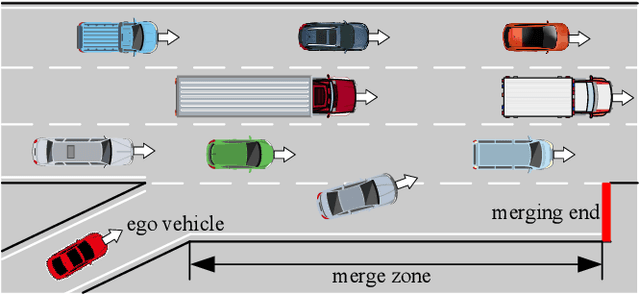
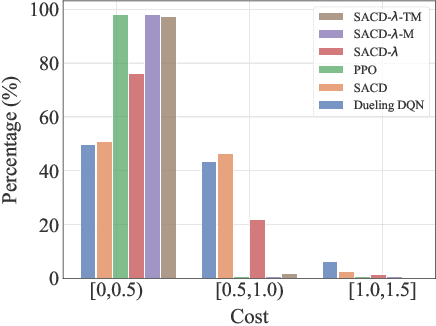
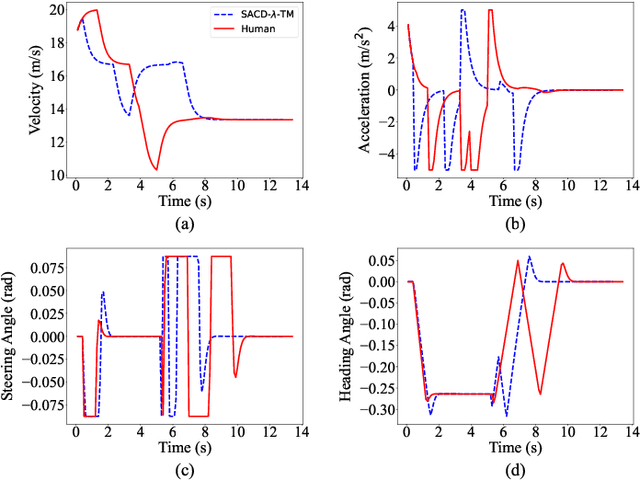
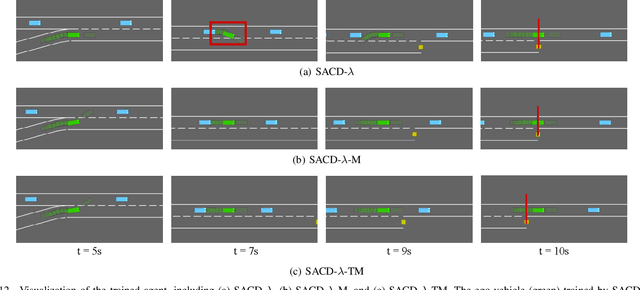
Abstract:Most reinforcement learning (RL) approaches for the decision-making of autonomous driving consider safety as a reward instead of a cost, which makes it hard to balance the tradeoff between safety and other objectives. Human risk preference has also rarely been incorporated, and the trained policy might be either conservative or aggressive for users. To this end, this study proposes a human-aligned safe RL approach for autonomous merging, in which the high-level decision problem is formulated as a constrained Markov decision process (CMDP) that incorporates users' risk preference into the safety constraints, followed by a model predictive control (MPC)-based low-level control. The safety level of RL policy can be adjusted by computing cost limits of CMDP's constraints based on risk preferences and traffic density using a fuzzy control method. To filter out unsafe or invalid actions, we design an action shielding mechanism that pre-executes RL actions using an MPC method and performs collision checks with surrounding agents. We also provide theoretical proof to validate the effectiveness of the shielding mechanism in enhancing RL's safety and sample efficiency. Simulation experiments in multiple levels of traffic densities show that our method can significantly reduce safety violations without sacrificing traffic efficiency. Furthermore, due to the use of risk preference-aware constraints in CMDP and action shielding, we can not only adjust the safety level of the final policy but also reduce safety violations during the training stage, proving a promising solution for online learning in real-world environments.
LAION-SG: An Enhanced Large-Scale Dataset for Training Complex Image-Text Models with Structural Annotations
Dec 11, 2024



Abstract:Recent advances in text-to-image (T2I) generation have shown remarkable success in producing high-quality images from text. However, existing T2I models show decayed performance in compositional image generation involving multiple objects and intricate relationships. We attribute this problem to limitations in existing datasets of image-text pairs, which lack precise inter-object relationship annotations with prompts only. To address this problem, we construct LAION-SG, a large-scale dataset with high-quality structural annotations of scene graphs (SG), which precisely describe attributes and relationships of multiple objects, effectively representing the semantic structure in complex scenes. Based on LAION-SG, we train a new foundation model SDXL-SG to incorporate structural annotation information into the generation process. Extensive experiments show advanced models trained on our LAION-SG boast significant performance improvements in complex scene generation over models on existing datasets. We also introduce CompSG-Bench, a benchmark that evaluates models on compositional image generation, establishing a new standard for this domain.
Distribution Backtracking Builds A Faster Convergence Trajectory for One-step Diffusion Distillation
Aug 28, 2024



Abstract:Accelerating the sampling speed of diffusion models remains a significant challenge. Recent score distillation methods distill a heavy teacher model into an one-step student generator, which is optimized by calculating the difference between the two score functions on the samples generated by the student model. However, there is a score mismatch issue in the early stage of the distillation process, because existing methods mainly focus on using the endpoint of pre-trained diffusion models as teacher models, overlooking the importance of the convergence trajectory between the student generator and the teacher model. To address this issue, we extend the score distillation process by introducing the entire convergence trajectory of teacher models and propose Distribution Backtracking Distillation (DisBack) for distilling student generators. DisBask is composed of two stages: Degradation Recording and Distribution Backtracking. Degradation Recording is designed to obtain the convergence trajectory of teacher models, which records the degradation path from the trained teacher model to the untrained initial student generator. The degradation path implicitly represents the intermediate distributions of teacher models. Then Distribution Backtracking trains a student generator to backtrack the intermediate distributions for approximating the convergence trajectory of teacher models. Extensive experiments show that DisBack achieves faster and better convergence than the existing distillation method and accomplishes comparable generation performance. Notably, DisBack is easy to implement and can be generalized to existing distillation methods to boost performance. Our code is publicly available on https://github.com/SYZhang0805/DisBack.
ETSCL: An Evidence Theory-Based Supervised Contrastive Learning Framework for Multi-modal Glaucoma Grading
Jul 19, 2024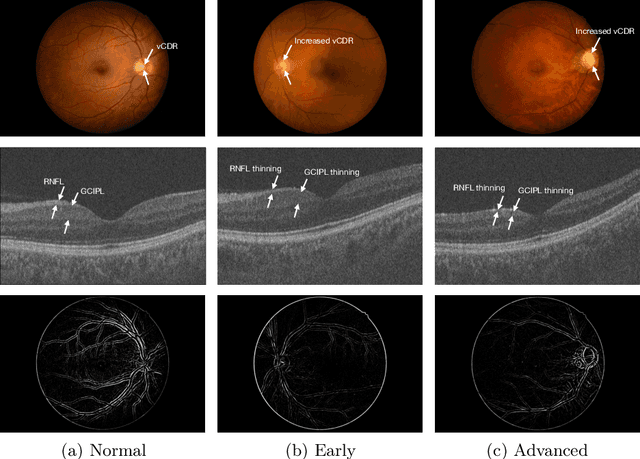
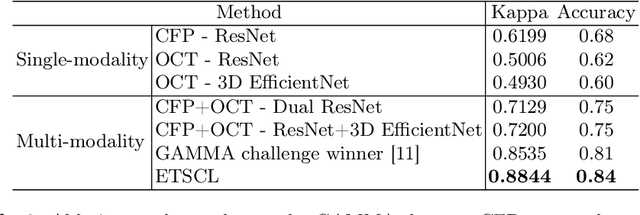
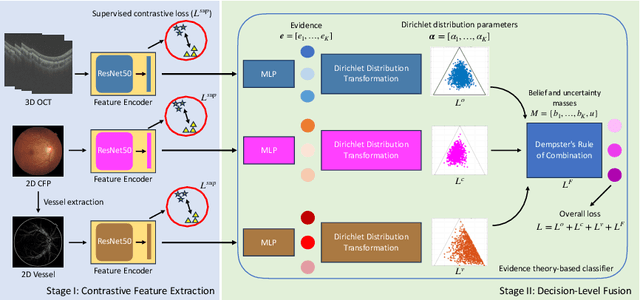
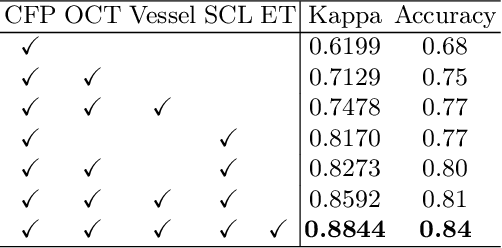
Abstract:Glaucoma is one of the leading causes of vision impairment. Digital imaging techniques, such as color fundus photography (CFP) and optical coherence tomography (OCT), provide quantitative and noninvasive methods for glaucoma diagnosis. Recently, in the field of computer-aided glaucoma diagnosis, multi-modality methods that integrate the CFP and OCT modalities have achieved greater diagnostic accuracy compared to single-modality methods. However, it remains challenging to extract reliable features due to the high similarity of medical images and the unbalanced multi-modal data distribution. Moreover, existing methods overlook the uncertainty estimation of different modalities, leading to unreliable predictions. To address these challenges, we propose a novel framework, namely ETSCL, which consists of a contrastive feature extraction stage and a decision-level fusion stage. Specifically, the supervised contrastive loss is employed to enhance the discriminative power in the feature extraction process, resulting in more effective features. In addition, we utilize the Frangi vesselness algorithm as a preprocessing step to incorporate vessel information to assist in the prediction. In the decision-level fusion stage, an evidence theory-based multi-modality classifier is employed to combine multi-source information with uncertainty estimation. Extensive experiments demonstrate that our method achieves state-of-the-art performance. The code is available at \url{https://github.com/master-Shix/ETSCL}.
Edge-guided and Cross-scale Feature Fusion Network for Efficient Multi-contrast MRI Super-Resolution
Jul 07, 2024



Abstract:In recent years, MRI super-resolution techniques have achieved great success, especially multi-contrast methods that extract texture information from reference images to guide the super-resolution reconstruction. However, current methods primarily focus on texture similarities at the same scale, neglecting cross-scale similarities that provide comprehensive information. Moreover, the misalignment between features of different scales impedes effective aggregation of information flow. To address the limitations, we propose a novel edge-guided and cross-scale feature fusion network, namely ECFNet. Specifically, we develop a pipeline consisting of the deformable convolution and the cross-attention transformer to align features of different scales. The cross-scale fusion strategy fully integrates the texture information from different scales, significantly enhancing the super-resolution. In addition, a novel structure information collaboration module is developed to guide the super-resolution reconstruction with implicit structure priors. The structure information enables the network to focus on high-frequency components of the image, resulting in sharper details. Extensive experiments on the IXI and BraTS2020 datasets demonstrate that our method achieves state-of-the-art performance compared to other multi-contrast MRI super-resolution methods, and our method is robust in terms of different super-resolution scales. We would like to release our code and pre-trained model after the paper is accepted.
GloSoFarID: Global multispectral dataset for Solar Farm IDentification in satellite imagery
Apr 08, 2024Abstract:Solar Photovoltaic (PV) technology is increasingly recognized as a pivotal solution in the global pursuit of clean and renewable energy. This technology addresses the urgent need for sustainable energy alternatives by converting solar power into electricity without greenhouse gas emissions. It not only curtails global carbon emissions but also reduces reliance on finite, non-renewable energy sources. In this context, monitoring solar panel farms becomes essential for understanding and facilitating the worldwide shift toward clean energy. This study contributes to this effort by developing the first comprehensive global dataset of multispectral satellite imagery of solar panel farms. This dataset is intended to form the basis for training robust machine learning models, which can accurately map and analyze the expansion and distribution of solar panel farms globally. The insights gained from this endeavor will be instrumental in guiding informed decision-making for a sustainable energy future. https://github.com/yzyly1992/GloSoFarID
Smooth Tchebycheff Scalarization for Multi-Objective Optimization
Mar 14, 2024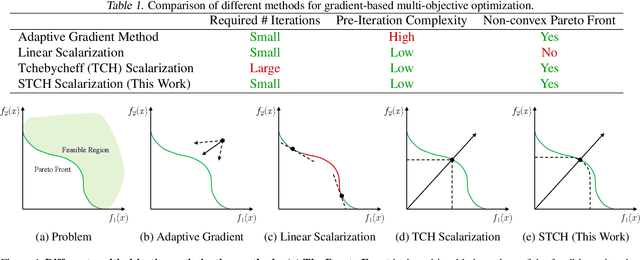

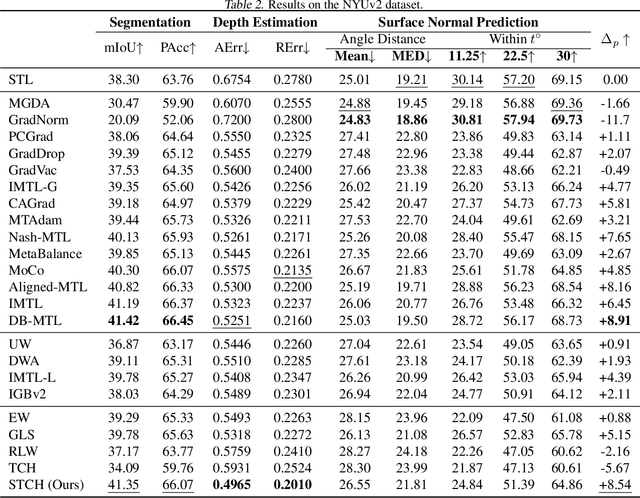
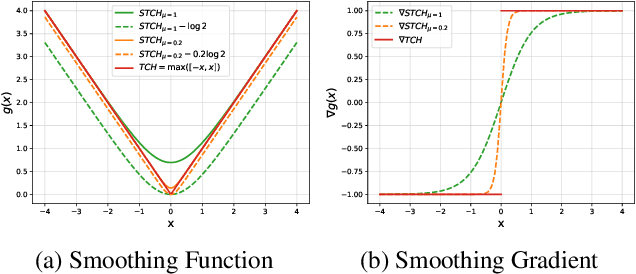
Abstract:Multi-objective optimization problems can be found in many real-world applications, where the objectives often conflict each other and cannot be optimized by a single solution. In the past few decades, numerous methods have been proposed to find Pareto solutions that represent different optimal trade-offs among the objectives for a given problem. However, these existing methods could have high computational complexity or may not have good theoretical properties for solving a general differentiable multi-objective optimization problem. In this work, by leveraging the smooth optimization technique, we propose a novel and lightweight smooth Tchebycheff scalarization approach for gradient-based multi-objective optimization. It has good theoretical properties for finding all Pareto solutions with valid trade-off preferences, while enjoying significantly lower computational complexity compared to other methods. Experimental results on various real-world application problems fully demonstrate the effectiveness of our proposed method.
Exploring the Adversarial Frontier: Quantifying Robustness via Adversarial Hypervolume
Mar 08, 2024Abstract:The escalating threat of adversarial attacks on deep learning models, particularly in security-critical fields, has underscored the need for robust deep learning systems. Conventional robustness evaluations have relied on adversarial accuracy, which measures a model's performance under a specific perturbation intensity. However, this singular metric does not fully encapsulate the overall resilience of a model against varying degrees of perturbation. To address this gap, we propose a new metric termed adversarial hypervolume, assessing the robustness of deep learning models comprehensively over a range of perturbation intensities from a multi-objective optimization standpoint. This metric allows for an in-depth comparison of defense mechanisms and recognizes the trivial improvements in robustness afforded by less potent defensive strategies. Additionally, we adopt a novel training algorithm that enhances adversarial robustness uniformly across various perturbation intensities, in contrast to methods narrowly focused on optimizing adversarial accuracy. Our extensive empirical studies validate the effectiveness of the adversarial hypervolume metric, demonstrating its ability to reveal subtle differences in robustness that adversarial accuracy overlooks. This research contributes a new measure of robustness and establishes a standard for assessing and benchmarking the resilience of current and future defensive models against adversarial threats.
 Add to Chrome
Add to Chrome Add to Firefox
Add to Firefox Add to Edge
Add to Edge